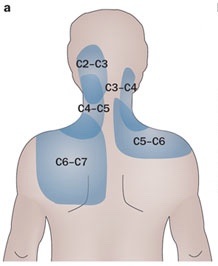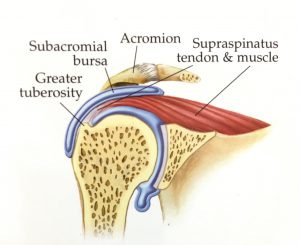Whiplash & Shoulder Pain – North County Chiropractor
1 in 4 Whiplash Injuries Develop Shoulder Pain
About 26% of individuals experiencing a whiplash injury from an auto collision develop shoulder pain. Determining the source can be a diagnostic challenge, therefore a detailed and thorough examination is essential.

In general, there are four injured structures that can contribute to shoulder pain. In some instance, the pain can be caused by a combination of injured structures. The following are the four most common injuries:
Injury to the muscles
When a collision happens, the head can be violently jerked or ‘whipped’ forwards and back or side to side. This rapid motion causes an over stretching of the muscles of the neck which results in inflammation and swelling.
What many people are unaware of is one of the muscle groups supporting the neck is the upper trapezius. The upper trapezius creates a rough triangle attaching at the base of the skull, stretching down to the top of the shoulder blade then out to the tip of the shoulder. See diagram
With the force of the impact, the upper traps can be stretched (strained) beyond their normal limits, resulting in damage to the muscle and pain in the neck radiating across the top of the shoulder.
Injury to neck joints called facets
 Most of the vertebra in the neck are held together by the disc in front and two small joints in the back called facet joints. Research has shown that these joints are one of the most commonly injured structures with a whiplash.
Most of the vertebra in the neck are held together by the disc in front and two small joints in the back called facet joints. Research has shown that these joints are one of the most commonly injured structures with a whiplash.
Further, research has also shown that besides moderate to severe neck pain, these facet joints have specific pain referral patterns, which include the shoulder, specifically the the lower cervical (neck joints). See diagram to the right.
Injury to cervical nerve roots
A third source of shoulder associated with a whiplash is injury to the nerve roots that exit from the neck (cervical spine) and run into the shoulder and down the arm.
Part of the mechanism of injury in a rear impact collision is a shearing motion of the vertebra in the middle of the neck. During this motion, part of the vertebra to roll over the nerve root and result in injury and inflammation and pain radiating into the shoulder.
In more severe cases, the impact either causes a disc herniation or inflames an existing disc bulge. This results in compression of the nerve root and the subsequent pain across the shoulder.
Subacromial impingement
A fourth, and often missed cause of shoulder pain from an injury is called a subacromial impingement. This happens when the top part of the shoulder joint is forced down and compresses on tendons of the rotator cuff or a bursa in the shoulder. Sadly, research show this condition is commonly missed and on average not found till 8 months after the collision!
There are multiple causes of shoulder pain after a whiplash type injury. It has been our experience that many general practitioners quickly asses the shoulder pain to either the muscle strain or jump to a pinched nerve. It has further been our experience that many times the facet injury or subacromial impingement are missed.
It is unfortunate when this happens because the patient continues to suffer and potentially develops long term degenerative problems and chronic pain.
As you can see, shoulder pain after an auto collision is quite common and can be due to many different things, proper testing is necessary to determine the cause.
If you have been in an auto collision and are suffering shoulder pain, call our office at (314) 731-4383, ask for Dr. Martin! We will schedule you for a thorough consultation and exam to get to the cause of your shoulder pain!
